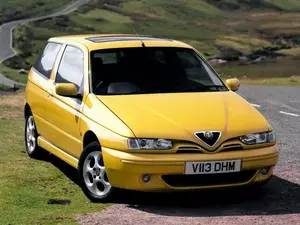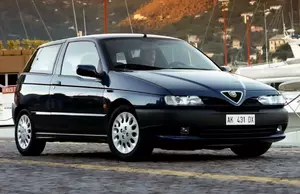
| Vehicle | Precise engine size | Difference from world average | Engine size to consumption ratio | Horsepower from 1 L | Engine size to 100 kg of weight |
|---|---|---|---|---|---|
| 1.9 JTD |
1.91 L (1910 cc) |
18.6% smaller | 47 cc to 1 mpg | 55 hp from 1 L | 159 cc to 100 kg |
| Vehicle | 1.9 JTD |
|---|---|
| Precise engine size | 1.91 L (1910 cc) |
| Difference from world average | 18.6 smaller |
| Engine size to consumption ratio | 47 cc to 1 mpg |
| Horsepower from 1 L | 55 hp from 1 L |
| Engine size to 100 kg of weight | 159 cc to 100 kg |

| Vehicle | Precise engine size | Difference from world average | Engine size to consumption ratio | Horsepower from 1 L | Engine size to 100 kg of weight |
|---|---|---|---|---|---|
| 1.4 i.e. |
1.35 L (1351 cc) |
42.4% smaller | 47 cc to 1 mpg | 67 hp from 1 L | 123 cc to 100 kg |
| 1.6 i.e. 16V T.S. |
1.6 L (1598 cc) |
31.9% smaller | - | 75 hp from 1 L | 133 cc to 100 kg |
| 1.4 i.e. 16V T.S. |
1.37 L (1370 cc) |
41.6% smaller | - | 75 hp from 1 L | 125 cc to 100 kg |
| 1.6 i.e. |
1.6 L (1596 cc) |
32% smaller | 55 cc to 1 mpg | 64 hp from 1 L | 145 cc to 100 kg |
| 1.7 i.e. 16V |
1.75 L (1747 cc) |
25.5% smaller | - | 82 hp from 1 L | 146 cc to 100 kg |
| 2.0 16V Quadrifoglio |
1.97 L (1969 cc) |
16.1% smaller | 70 cc to 1 mpg | 79 hp from 1 L | 164 cc to 100 kg |
| 1.9 TD |
1.93 L (1929 cc) |
17.8% smaller | 51 cc to 1 mpg | 47 hp from 1 L | 161 cc to 100 kg |
| 2.0 16V T.S. |
1.97 L (1970 cc) |
16% smaller | 68 cc to 1 mpg | 76 hp from 1 L | 152 cc to 100 kg |
| Vehicle | 1.4 i.e. |
|---|---|
| Precise engine size | 1.35 L (1351 cc) |
| Difference from world average | 42.4 smaller |
| Engine size to consumption ratio | 47 cc to 1 mpg |
| Horsepower from 1 L | 67 hp from 1 L |
| Engine size to 100 kg of weight | 123 cc to 100 kg |
| Vehicle | 1.6 i.e. 16V T.S. |
| Precise engine size | 1.6 L (1598 cc) |
| Difference from world average | 31.9 smaller |
| Engine size to consumption ratio | - |
| Horsepower from 1 L | 75 hp from 1 L |
| Engine size to 100 kg of weight | 133 cc to 100 kg |
| Vehicle | 1.4 i.e. 16V T.S. |
| Precise engine size | 1.37 L (1370 cc) |
| Difference from world average | 41.6 smaller |
| Engine size to consumption ratio | - |
| Horsepower from 1 L | 75 hp from 1 L |
| Engine size to 100 kg of weight | 125 cc to 100 kg |
| Vehicle | 1.6 i.e. |
| Precise engine size | 1.6 L (1596 cc) |
| Difference from world average | 32 smaller |
| Engine size to consumption ratio | 55 cc to 1 mpg |
| Horsepower from 1 L | 64 hp from 1 L |
| Engine size to 100 kg of weight | 145 cc to 100 kg |
| Vehicle | 1.7 i.e. 16V |
| Precise engine size | 1.75 L (1747 cc) |
| Difference from world average | 25.5 smaller |
| Engine size to consumption ratio | - |
| Horsepower from 1 L | 82 hp from 1 L |
| Engine size to 100 kg of weight | 146 cc to 100 kg |
| Vehicle | 2.0 16V Quadrifoglio |
| Precise engine size | 1.97 L (1969 cc) |
| Difference from world average | 16.1 smaller |
| Engine size to consumption ratio | 70 cc to 1 mpg |
| Horsepower from 1 L | 79 hp from 1 L |
| Engine size to 100 kg of weight | 164 cc to 100 kg |
| Vehicle | 1.9 TD |
| Precise engine size | 1.93 L (1929 cc) |
| Difference from world average | 17.8 smaller |
| Engine size to consumption ratio | 51 cc to 1 mpg |
| Horsepower from 1 L | 47 hp from 1 L |
| Engine size to 100 kg of weight | 161 cc to 100 kg |
| Vehicle | 2.0 16V T.S. |
| Precise engine size | 1.97 L (1970 cc) |
| Difference from world average | 16 smaller |
| Engine size to consumption ratio | 68 cc to 1 mpg |
| Horsepower from 1 L | 76 hp from 1 L |
| Engine size to 100 kg of weight | 152 cc to 100 kg |